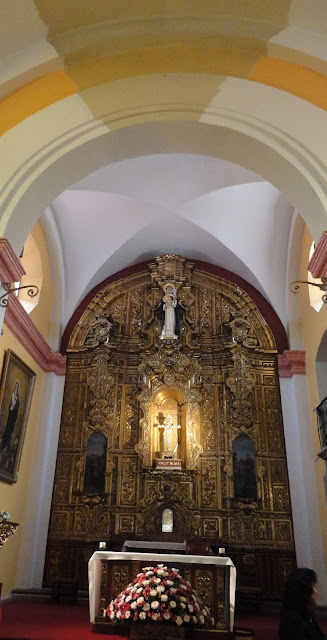The mint is located in a transformed 16th century hacienda. Although it is now in the center of the downtown, at the time it was built, this was the very outskirts of the city.
Typical of the homes of the period, the rooms were centered around an interior courtyard. This was ideal for the mint, because the ore could be brought from the street and put in this central courtyard, where it was secure.
 |
| What could be behind this door?
|
After some opening words of introduction and explanation, our guide led us to this door -- not very impressive or noteworthy. Until he opened it.
This cavernous room looked to be at least two square blocks in area -- with walls and ceilings and floor blackened from the soot of years of coal burning to melt the ore, plus the ancient and grimy equipment -- it looked like something out of a Dickens novel.
Above is a picture of the oven where the copper, silver, and gold were melted. If ever I'm having a bad day at work I'll remind myself of these guys who worked 12 hours a day, six days a week in the foundry, handling molten metal, in a room that averaged 55 degrees Celsius (that's 131 degrees Fahrenheit). To keep cool in the heat the workers wore felt aprons (that's wool!) soaked in water and were allotted 4 liters of pulque daily.
 |
| Above is the product that came out of the foundry -- metal ingots. |
I had always thought that coins were made by pouring molten metal into a mold, and letting the metal cool off and solidify. Actually, the 'blanks' receive their image by pressure (26 tons of pressure -- or something like that) in a machine that looks like this:
Blanks are put in the cup to the left, and after being impressed come out the shute into the box on the floor.
The machine pressed out the design above -- I was told that it is one of the most famous and considered one of the most beautiful coins ever designed. The coin is named for the 'columns' to the left and right of the globe and crown in the center. The ribbon coiled around the column inspired the sign for Mexican pesos -- an 'S' with one vertical line through it --$. (The US dollar sign supposedly has two vertical lines through it.) I also learned that over the years Mexico has been considered one of the premier locations in the world for the design and making of coins and medals. It makes sense, since so much precious metal has been mined here over the years.














